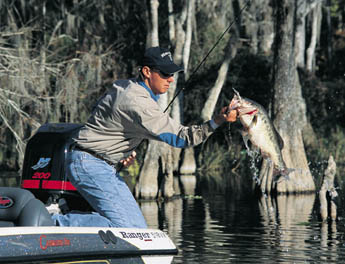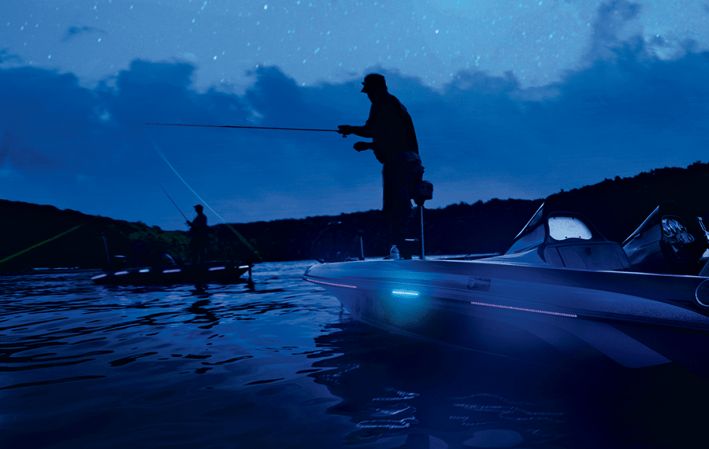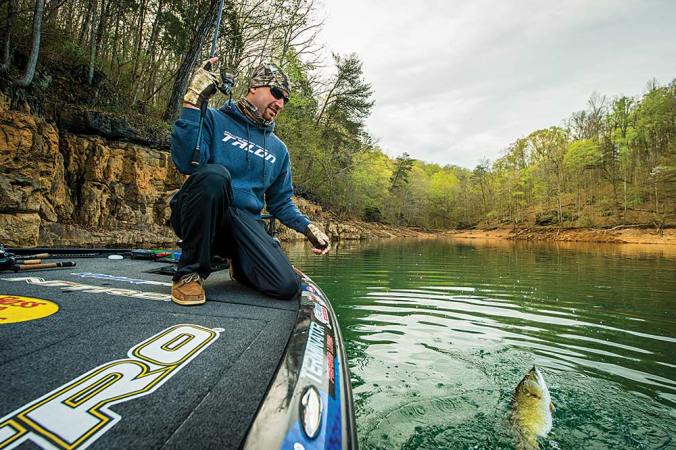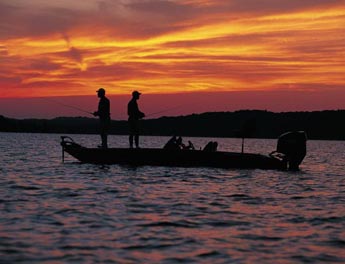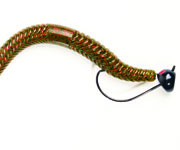Did you ever fisha spot where you knew there had to be a bass, yet you didn’t catch it? Maybe itjust wasn’t biting. Or perhaps you didn’t throw the right bait, or maybe therewasn’t a fish there after all. Move on, you tell yourself. Yet sometimesnagging doubts persist; there should have been a bass back there.
Sometimes theproblem is as basic as lining up a boat in relation to cover or structure sothat lure presentations cover the strike zone. Positioning a boat effectivelyalso might depend on a number of factors, including the clarity and depth ofthe water being fished and the distance to targets. Regardless of thecircumstances, if you don’t have a game plan in mind before the first cast, thebest you can do is get lucky; the worst is to spook bass away with a clumsyapproach.
Consider somecommon bass-fishing scenarios and how experienced anglers position their boatsto make every cast irresistible to even the laziest of lunkers.
1 WORK THE WHOLELOG ROLAND MARTIN SLOWLY STEERED his boat through the jumbled maze of fallen andstanding dead trees that once stood along the Arkansas River.
Studying the wateras the boat inched forward, Martin finally took his foot off the trolling motorpedal and reached for his buzzbait outfit. After he cast down the side of a logthat poked out from an island of flooded grass, I asked him why he hadn’t castto any other targets coming in.
“For onething, the other logs are running every which way, and this one is runningfairly straight out from shallow water to where the bottom drops off to deeperwater.” Answered Martin. “Before you cast, you want your boat lined upso you can run a lure down the entire length of a log. The idea is to run itacross the surface of the water for a distance so that a bass next to the logor under it can home in on the lure’s direction of travel and grab it.”
Just then,Martin’s buzzbait disappeared in a swirl and he reared back on his rod. Lessonlearned. Best Bait Designed to plane quickly and create motion during the retrieve, this buzzbaitis painted with a large eye and red gills. Its silicone skirt flares for addedattraction. PRO TIP: The best logs to fish are those that extend from shallow to deepwater. Typically bass will station themselves near the end of a log, so keepthe boat well offshore and focus on the deep end. Never pass up a log juttingout from a shoreline that is otherwise barren of brushy cover. 2 PLUMB ALONG THE POINTS TIM HORTON’S APPROACH TO fishing points is fairly straightforward. Most of thelakes where he fishes have literally hundreds of points, and Horton doesn’thave time to fool around when he’s in a tournament. As he nears a likely point,the Alabama pro approaches from the side and begins lobbing crankbaits over thepoint from the down-current side. If, for example, the point runs from theshore out about 150 feet and descends from 2 feet deep to 20 feet deep, Hortonfishes the shallow-to-deep zones with Fat Free Shad crankbaits.
“The key towhere I position the boat relative to the point depends on which way the windis blowing or the current is flowing,” says Horton, a former B.A.S.S.Angler of the Year. “You always want to cast your line up-current, whetherthe current is caused by wind or by the flow water being pulled by adam.”
Horton says thebiggest mistake most anglers make is to position their boats on top of a pointand then cast directly up and down it. Best Bait This deep-diving Fat Free Shad crankbait has a flat-sided design that offerseasy retrieves with maximum control. Kick-out paddles allow the lure to pulleasily through submerged weeds. PRO TIP: The best points are the ones that are perpendicular to current flow,rather than those that run parallel to it. Bass prefer points that are currentbreaks because their down-current sides are good ambush spots for baitfish. 3 DROP DOWN ON A LEDGE IN THE HEAT OF SUMMER OR THE dead of winter, fishing ledges for suspended bassis the best way California pro Dave Rush knows to fill an empty livewell. Ifthe weather is cold, Rush positions his boat directly over a drop-off.
“Usually, fishwill hold near the bottom and back up right against the wall of the drop-off orledge,” says Rush. “Then you want to lower a jig, tube, lizard ordrop-shot rig right in front of their noses. I also like to jig a Cordell Spot[a lipless crankbait] in the winter.”
In the summer,bass might be 20 feet away and hang closer to the top. Approach a ledge fron adistance and then begin fan-casting a topwater lure such as a Zara Spook or adiving crankbait such as a Fat Free Shad. If the wind is blowing from theshore, Rush positions his boat out from the ledge and casts toward the bank, ashe believes the fish are facing that way. When the wind is blowing toward land,he positions his boat on the inshore side. Best Bait A topwater lure that’s ideal for shallow-swimming bass, the Zara Spook moves ina side-to-side action when an angler uses a rhythmic, slack-line retrieve. PRO TIP: Approach a ledge carefully and quietly, as if you were going to fishthe shore-line. Though ledges are often associated with deeper water,bass–especially spotted bass–are just as sensitive to noise as they would beif they were near shore.
4 LOOK FOR CREEKCOVER WHEN IT COMES TO FISHING THE standing timber in the East Texas impoundment ofLake Fork, Mark Pack is a specialist. “Basically, when cover is everywhere,you pay closer attention to the bottom structure,” says Pack, who owns LakeFork Tackle. “I look for ambush points: ledges, points, humps. Bass alwaysposition themselves next to such structure. Cover is a bonus.”
Instead ofwandering aimlessly through flooded timber, Pack keeps his boat near the middleof creek channels, sticking to the shady sides and casting his lures so theycan be worked along the edges of points, humps or similar structure. Pack hasschooled himself in translating what the dead timber is saying about thetopography beneath the surface. He concentrates his fishing efforts where treesstand at the edge of structure, positioning his boat so he can cast a jig pastthe timber pump it back a few feet under the surface. “You want to bringthe jig up to the tree and then let it fall vertically,” says Pack.
Best Bait Jigs come in all sizes, shapes and weights. The most popular are dressed withrubber legs or fur. A weed-guard in front of the hook enhances the lure’sversatility, and a pork, plastic or fur trailer adds to its appeal. PRO TIP: Flooded trees that stand taller than those of similar girth aroundthem might indicate a hump, hill or point. Scattered smaller trees emergingfrom a stand of larger trees suggest a steep slope or rocky bluff. Trees thatjut into a channel signal a point. 5 CAST ALONG THE ROCKS WHEN CONNECTICUT ANGLER Herb Reed positions his boat to fish a bridge piling orrocks, his first consideration is the lure he’s got tied on the end of hisline.
“If I’mfishing boulders with a deep-diving crankbait, for instance, I will positionthe boat differently from how I would if I was using a jig orsoft-plastic,” says the founder of Lunker City Lures.
“I usuallyavoid casting across the rock with a diving plug, especially when fishing froma distance. I don’t want to drag the line across the rough surface when theretrieve pulls the lure up along the far side of the boulder. I move the boatto change my casting angles so I can run the lure along the face of theboulder, across the back and down each side.”
When fishing therock with a Slug-Go or even with a lipless rattling plug, Reed isn’t asconcerned about pulling the line across the rock surface because there’s not asmuch tension on it as there is when retrieving a diving crankbait.
Best Bait This Cordell Super Spot lipless crankbait attracts fish with the sound andvibration of multiple rattles. Good for a variety of depths, the lure isavailable in 12 colors, including Texas Red (pictured). PRO TIP: When current is running, position your boat parallel to a channeldrop-off to fish bridge pilings and seawalls. To brush the structure all theway down when casting jigs or plastics, put the boat against the wall or pilingand cast directly up-current. 6 COVER THE TREE TOPS DOW GILMORE OF CHIPLEY, FLA., has a systematic approach to fishing a tree thathas toppled into the water. He stations his boat parallel to the bank and thencasts beyond the treetop so that by the time his Bagley crankbait (gray shad)reaches it, the lure will have descended to its maximum depth.
If that approachdoesn’t draw a strike from a big bass, Gilmore slows the speed down on hissubsequent retrieves so that the lure covers the water column from top tobottom.
Next, he pullsinto deeper water so that he’s at the head of the treetop. Then he pitches orflips a plastic worm or jig into the branches. He follows that with casts intothe shallower water beyond the branches and along the length of the trunk.
If that fails,Gilmore casts a buzzbait or plastic worm the length of the tree and works itback toward the boat. This thorough method of fishing baits around a partiallysubmerged tree works best when there is little other structure along thebank. Best Bait Featuring a balsa wood body, weighted lip and brass hardware, a Bagley lureretrieves with a lot of wobbling action. The original DKB2 has beendiscontinued, but its offspring can be found in Bagley’s Original series. PRO TIP: Concentrate fishing efforts on fallen trees whose branches over-hang adrop-off. Treetops in shallow water or extending far out into the current areless likely to hold fish.

